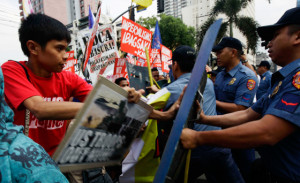DEFENSE Secretary Voltaire Gazmin confirmed on Thursday that the United States will build five military facilities in various areas under the Enhanced Defense Cooperation Agreement (EDCA), which was recently declared legal by the Supreme Court.
Gazmin’s confirmation came a day after US Ambassador to the Philippines Philip Goldberg disclosed that the US will fund the construction and upgrading of five facilities inside military camps.
He said the “agreed upon sites” are Palawan, Lumbia in Cagay an de Oro City, Fort Magsaysay in Nueva Ecija, Basa Air Base in Pampanga and Cebu. The Defense chief disclosed that discussions on these projects are halfway through.
He, however, could not say what the first project will be since this will depend on the priority of US authorities.
On Wednesday, Goldberg said the construction of military facilities is one of the provisions of EDCA.
“Everything that we will do under EDCA will be mutually agreed. We agreed to certain military construction to help upgrade those facilities using the US military construction funds. It will all be jointly decided and that’s why we’re in the process of doing that now we have a favorable Supreme Court ruling,” he added.
Col. Noel Detoyato, chief of the Armed Forces of the Philippines (AFP) Public Affairs Office, clarified that the construction projects will involve the upgrading of facilities in existing military camps, not building separate military bases.
But the official could not say what kind of facilities will be built or enhanced “because it has to be mutually agreed based on inspection of camps to be jointly used for training.”
Earlier, Brig. Gen. Restituto Padilla, AFP spokesman, said the US and the Philippines may complete installation of a US facility in the country not for military use but for humanitarian assistance and disaster response (HADR).
He added that the US can establish such facility in the AFP General Headquarters in Camp Aguinaldo (Quezon City), Fort Magsaysay in Nueva Ecija, some camps in Central Visayas, Mactan Air Base or Camp Lapu Lapu both in Cebu and Camp Peralta in Jamindan in Capiz.
These camps, Padilla said, are being considered as jumping boards for disaster response.
US authorities will be allowed to store and keep items related to HADR operations, he added.
The items include power generators, lightings, water purifiers and mobility equipment like trucks, heavy lifters and forklifts.
“The storage of equipment right now is limited to HADR equipment, so no tanks, no war fighting equipment for the moment,” Padilla said.
Goldberg said no timetable has been established for the construction of the facilities.
“We’re in discussions constantly with our colleagues from the Department of National Defense and the Department of Foreign Affairs to actually watch out exactly on how and when we are going to do this. It is a process that will involve both sides agreeing to carrying out EDCA terms,” he told reporters.
“What we do in military construction funds and things that we have available are also subject to appropriations by our Congress so we don’t know fully what will be offered. In the previous time, we have about $66 million for the military funding in process for the Philippines and we expect there will be additional sources of funds for carrying out EDCA through military construction funds,” the US ambassador said.
He noted that through EDCA, the Philippines will be able to modernize its Armed Forces.
“In large part, it is to address the 21st century challenges, not just the challenges of the past,” Goldberg said.
These “21st century challenges” involve maritime security and maritime domain awareness.
“I know that Japan and Australia and others are also participating in helping the Philippines as it goes about building this defense,” Goldberg said. “Other countries have a role to play in the development of the Philippines’ military sector but the EDCA agreement is between the United States and the Philippines and the other countries don’t play a role in that.”
The ambassador said the US is very committed in helping the Philippines.
“The United States and the Philippines are treaty allies, we have a mutual defense treaty from 1951. It makes it the oldest defense treaty that we have in this region and we have commitments to the Philippines and the Philippines has commitments to the United States under that mutual defense treaty,” he noted.
The ambassador said the US will consider joint patrols with the Philippines in the West Philippine Sea (South China Sea) as part of efforts to ensure freedom of navigation in waters claimed by China.
Washington angered Beijing in recent months by sending US warships and warplanes on patrols near artificial islands built by China to bolster its claim to most of the sea.
The Philippines, one of five claimants to parts of the waterway, has backed Washington’s military actions and last month suggested joining US patrols.
“The United States... will continue to enjoy our rights under international law to sail through international waters or fly through international airspace. So I’m not going to prejudge what we’re going to do or when we’re going to do it. Whether we’re going to do it with the Philippines... I’m not discarding that possibility,” Goldberg said.
When asked later if he thought the US would say “yes” if the Philippines formally asked to take part in joint patrols in the South China Sea, he replied, “I think so.”
“I don’t think there are any limitations on what the US can do,” Goldberg said.
With AFP


